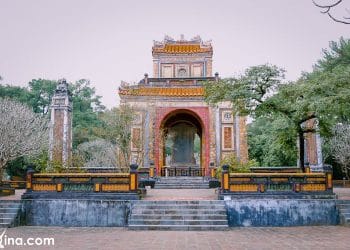Hue is famed for the beauty of natural landscapes and the solemnity of the imperial citadel, temples, ancient pagodas. Taking a trip here, tourists should not miss Voi Ré palace, one of the historic architectures of Hue, former capital of Vietnam.
Paying a visit to Hue – the ancient and poetic city, tourists cannot ignore historic monuments, landscapes and historic space. Besides royal tombs, temples and pagodas, beautiful and romantic sceneries in Hue, it is worth visiting one cultural monument which was recognized as a national monument in 1998 – Voi Ré palace.
- The Complex Of Hue Monuments Photos – A UNESCO World Heritage Site in Vietnam
- Most Famous Pagodas In Hue Photos – Vietnam’s Must-Visit Temples
Voi Re Palace: Cultural Monument Under Nguyen Dynasty
- Location:
About 5km from The west of Hue city, Voi Ré palace belongs to Truong Da hamlet, Thuy Bieu, Thua Thien Hue. This palace was conventionally regarded as the witness of brave and loyal elephants in the Nguyen Dynasty, also the unique monument of Hue ancient capital.
- History And Meaning:

Voi Ré palace was properly considered the place to pay honour to elephants – the essential animals in war and transportation in the past. Legendarily, it was originated from the loyalty, love of animal servants to owners; therefore, the public adored elephants as the spiritual god. Voi Ré palace now worships the shrines of the most four brave elephants with the brilliant feat of arms under Nguyen Dynasty. Those brave elephants were conferred Commander-in-chief featuring: Tượng Ré, Tượng Bích, Tượng Nhĩ and Tượng Bôn.
Under the conflicts between the Trinhs and the Nguyens, a courageous general of Đàng Trong (the region in central Vietnam) unfortunately died before the battle. In front of the death of the owner, the elephant continuously ran hundreds of miles to Phu Xuan imperial city. When arriving at Tho Cuong hill, it suddenly trumpeted a long resound indignantly, then breathed its last. In a great deal of sympathy with the elephant’s loyalty to its owner, the local people appealed to others to bury the elephant with the ceremony and rituals and build the tomb for it; then people often call it Voi Ré tomb. Emperor Gia Long, after enthroning, King Gia Long wished to worship the most loyal elephants dying in the battle; then he built the palace next to Voi Ré tomb. This palace was called Voi Ré palace.
- Architecture:

The palace was constructed according to the Oriental geomantic rules; the convex wall was applied to become the screen of the palace. Next to is Điện lake, an essential geomantic element of this palace, which betters the aesthetics of Voi Ré palace. This lake floods the smell of lotus flowers in summer; water is fresh in winter. With the square area of 1000m2, this lake appears a peaceful but bright pink colour from lotus flowers in the summer. About the depth of 3m, the lake is in the integrity of two sides without building stone.
The most important structure is Long Châu temple. Said to resemble other architectures, Long Châu temple was built in “trùng thiềm điệp ốc” style (a traditional style of Vietnam architecture). The main house consisted of five compartments and two lean-tos with the “ ngói liệt” roof (a kind of tile made from clay with the rectangle shape). The inner was decorated with the “liên ba” system (including decorated boxes used to fill the space among pillars, barges) with 104 more decorated boxes compared to other palaces; most of them were decorated with the word “Thọ” and bird patterns. According to the previous researchers, the back part of the palace was the temple –where to worship 15 Guardians with the shrines; however, in the temple, there are now four shrines of Gods: Thiên Sư, Chúa Động, Hồng Nương, and Tiền Hậu Khai Khẩn
The north is ancient Long Châu temple; the south has the quiet and solemn three-gate entrance. Tourists feel peaceful in mind and stirred in their heart because of the architecture here. In front of the three-gate entrance, there is a system of steps, including 17 ancient and magnificent steps. Straight to the main path, tourists can see a beautiful Long Mã screen with the ancient architecture.
Two sides of Long Châu temple are two secondary houses called Đông Phối Điện and Tây Phối Điện. They are used to worship elephants having a great deal of deed of arms in battles during Nguyen Dynasty’s establishment and are also the place to receive distinguished guests after ceremonies. In front of two houses, there are two extra temples to worship the Elephant (so-called Tượng temple).

- Function:
After the completion of Voi Ré palace, the court granted a great amount of money to organize the ritual twice a year in spring and autumn. The faithful elephants were adored in the same position to gods. Besides, this palace worshipped other Gods with the local people’s aspiration to protect those brave elephants. In 1825, King Minh Mang considered the merit of the Gods in the protection of elephants, so he bestowed Voi Ré palace and conferred a title “Trợ Oai Tượng Võ Linh Ứng Hộ Tượng chi thần” on Gods (means “credit for protection on elephants).
View more:
- 23 Must-See Hue Attractions – What To See In Hue, Vietnam
- Top 5 Places Should Be Explored in Hue Imperial Citadel, Vietnam
- 17 Things To Do In Hue – Best Activities In Hue, Vietnam
- Hue Food And Cuisine – Top 8 Best Foods To Eat In Hue
Voi Ré palace is considered the symbol of loyalty and courage. In particular, this place shows deep gratitude of local people to the brave animal – elephant. Hence, if tourists come to this place, they will have a chance to have sympathy for the architecture for these loyal animals.
By Minh Phuong















